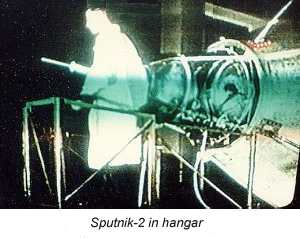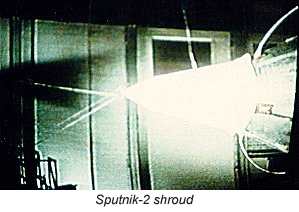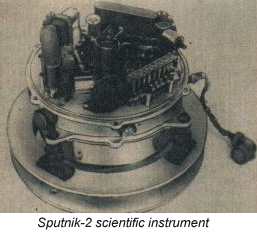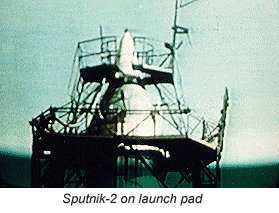Sputnik 2 - was it really built in less than
a month?
Sven Grahn
 Now
that the anniversary of Sputnik 1 has passed, maybe we shall give some
thought to the reallly shocking event of the early space age, the launch
of Sputnik 2, which took place from Tyuratam at 0230:42 UT on November
3, 1957.
Now
that the anniversary of Sputnik 1 has passed, maybe we shall give some
thought to the reallly shocking event of the early space age, the launch
of Sputnik 2, which took place from Tyuratam at 0230:42 UT on November
3, 1957.
The problem
In most accounts that have been
published in connection with the Sputnik 1 anniversary, we have heard that
the people working on the Sputnik 1 /R-7 launch were called back from a
well-deserved vacation just days after the successful Sputnik 1 launch
and asked to build and launch a second satellite in less than a month.
When repeatedly asked about this effort the participants in this work that
are alive today say there had been absolutely no preparations until Khrushchev
called Korolev and asked that another satellite be launched.
We have also recently heard
the same thing about Sputnik 1. Boris Chertok said at his talk at IAF97
in Turin that "we built Sputnik 1 in a month or two..." (if I remember
it correctly). Even James Oberg says in his book "Red Star In orbit" that
"A simple test satellite was thrown together in one of the smaller machine
shops in the assembly building" (p. 31). Of course we now know that the
preparations for Sputnik 1 had been lengthy. In Asif Saddiqis excellent
review "Korolev,
Sputnik and The International Geophysical year" we learn that Tikhonravov
and Korolev began discussing Sputnik 1 as a stop-gap measure until Object-D
(Sputnik 3) would be ready in November 1956! So, when our Russian friends
say something was built from scratch in a short time, perhaps we should
take that to mean that the final assembly and test was done in such a short
time. I think there could be a problem of language here.
In any case, I wish to present
arguments here to the effect that some, but certainly very far from all,
technical preparations had been made before Khrushchev's request to Korolev
to launch a second satellite.
The arguments for previous preparations
-
In Siddiqi's paper mentioned
above we also learn that Korolev presented a plan to launch a series of
satellites, including one with animals, at a meeting at the Academy of
Sciences on 30 August 1955.
-
In a document
describing the conceptual design of an artificial earth satellite, dated
25 September 1956, Sergei Korolev mentions (as the 8 th and last point)
that among the investigations that could be carried out on board the first
satellite was "studies of possibility of survival and life of animals during
long-term residence on board a spaeccraft".
-
In the book "Roads to Space",
Abram M Ghenin says on p 44: "While we were launching sounding rockets
carrying animals we were also making preparations for launching the first
artificial Earth satellite with an animal onboard.".....
-
...."My role in the preparations
for the launch of the dog Laika was minor, as I was still engaged in sending
up sounding rockets, and the two activities ran almost in parallel."....
-
...."My only contribution (to
Sputnik 2) was to design a new system of air regenarion in the animal's
compartment,...The challenge was to design a device which would adjust
the oxygen level being fed into the cabin to match the needs of the animal
without causing either oxygen excess or deficiency. Together with two colleagues
I managed to develop such a device."....
These three extracts
seem to indicate that the launch of Laika was planned well in advance.
-
In the same bok ("Roads to Space")
Arkady I Ostashov on p. 294 describes how everyone was called back from
vacation after the Sputnik 1 triumph around October 11 and that the Sputnik
2 R-7 booster was sent to Tyuratam on October 18!!!! Would all the modifications
necessary have been made in just one week? I doubt that. Of course some
changes could have been made at the launch site.
-
In "Roads to Space" Yuri A.
Mozzhorin (worked on R-7 TT&C systems at NII MO) explains (p.413) that
"The second satellite, carrying the dog Laika, was equipped with a telemetry
transmitter, thereby allowing the Tral-D equipment to be activated (Tral-D
TM system was developed for Object-D, but not used on Sputnik 1, SG:s comment),
The satellite also featured a slow-scan TV camera (100 lines per frame,
10 frames per seond), which relayed images to the ground on the Tral frequency".
(We now know that Sputnik 3 transmitted on 66 MHz and that the Tral-D system
operated in the range approx. 60-85 MHz). Desiging such systems are not
something you do in a couple of weeks!
As Bart Hendricx has
pointed out the choice of not separating the dog-cabin from the launch
vehicle made it possible to use the Tral telemetry system on the R-7 booster.
[In Ostashov's text there
is a description of the hurried design (and fixes made at the launch pad)
of a timer that would permit saving battery power by switching the "Tral"
transmitter on for 15 minutes every orbit. I think this is a genuine example
of something that was done in the last three weeks before launch.]
-
Constantine Domashnev has provided
the following quotes:
From (2):
 On
page 548
On
page 548
"To speed the work up,
Sergei Pavlovich proposed to simplify the construction and not to separate
the container with the dog from the booster: - Besides simplicity, - the
Chief said, - this will allow us to bypass the part of the heat through
the metal of the construction and help us keep an animal from overheating."
On page 549:
"When Korolev was giving
Khruschev a promise to greet the Soviet people with a new space wonder
by the celebration [of 40th anniversary of the October Revolution], he
understood what he was risking. However, the Chief designer had a small
zadel [? deposit; ? work already done], the very same one, which separated
this promise from the gamble [? / bluff]. In fact, the academical "Object-D"
was planned in three variations. The first one was materialized in our
third satellite. The second was supposed to be orientable. The third allowed
a container with test animals."
From (3)
p 301:
"Less than a week after
the launch of the first satellite, S.P. Korolev held meeting on the second
satellite, to which [satellite] he had been paying a special attention.
[Discussion of the foreign press reaction to the Sputnik] ... "
On page 304: [The same meeting]
 "Sergei
Pavlovich asked Ivanovskii:
"Sergei
Pavlovich asked Ivanovskii:
'- The very essence,
Oleg Genrihovich'.
'- All works on the second
satellite are on schedule. There are no deviations from the plan, - the
constructor reported. - The on-board installation of the device to study
Sun ultraviolet and X-ray radiation is completed. Cylindric chamber for
a test animal has been kept within strict limits: length - 80 centimeters,
diameter - 64. The weight is within limits as well. The total mass - animal,
apparatus, power sources - about 500 kg.'...."
-
On Sputnik 2 there was also
a spectrophotometer for UV (1216 A) and Soft-X-rays (1-120 A) using a photomultiplier
tube and a filterwheel. This instrument sent data through a commutated
telemetry channel. The instrument designed by the St. Peterburg physicist
A. Jefremov under the direction of Academicians A. Lebedev and S. Mandelstam.
-
Another item that needed development
for Sputnik 2 was the ejectable nose shroud. It was not simple device,
and according to some sources it did not work, thereby causing the overheating
and death of Lajka.
Conclusion
My guess is that some preliminary
work had been done, but that the work had to be speeded up feverishly after
Khrushchov's demand to put something up before Nov 7. Let me quote Abram
M Ghenin again (1 p.44): "I was always
amazed by Korolev's working method. Even before the goal of the current
activity had been attained, preparations were already under way for the
next step, and the steps beyond that."
 But
still, the Sputnik 2 tale is bordering on the incredible.
But
still, the Sputnik 2 tale is bordering on the incredible.
Afterthought
Finally, let me end with a tribute
to Lajka. It was the launch of this little dog that really fired up the
imagination of humankind. It triggered many persons on to a career in space
science and technology, including myself. When Lajka flew, I was eleven
years old, but realized that "Man will fly in space, and I will live to
see it!"
That Lajka had to die for
human space travel is of course a sad and disturbing fact. It reminds me
of the folk tale about the Ponte della Maddalena, a bridge near Lucca in
Italy's Tuscany province. This bridge is also known by the locals as "The
Devil's Bridge", because legend has it that the builder requested Satan's
help in order to complete it. In exchange the devil accepted the soul of
the first body to cross over. The builder cunningly avoided sending a human
being to hell by first sending a dog over the bridge........
References
-
"ROADS
TO SPACE, An oral history of the Soviet Space Program", edited by John
Rhea, translated by Peter Berlin and published by the Aviation Week group
in 1995.
-
Golovanov,
Yaroslav, "Korolev" ( Moscow, "Science", 1994)
-
Romanov,
Alexander, "Korolev" ( Moscow, "Young Guards", 1996)

 Back
to Space History Notes
Back
to Space History Notes
 On
page 548
On
page 548
 "Sergei
Pavlovich asked Ivanovskii:
"Sergei
Pavlovich asked Ivanovskii:
 Now
that the anniversary of Sputnik 1 has passed, maybe we shall give some
thought to the reallly shocking event of the early space age, the launch
of Sputnik 2, which took place from Tyuratam at 0230:42 UT on November
3, 1957.
Now
that the anniversary of Sputnik 1 has passed, maybe we shall give some
thought to the reallly shocking event of the early space age, the launch
of Sputnik 2, which took place from Tyuratam at 0230:42 UT on November
3, 1957.
 But
still, the Sputnik 2 tale is bordering on the incredible.
But
still, the Sputnik 2 tale is bordering on the incredible.